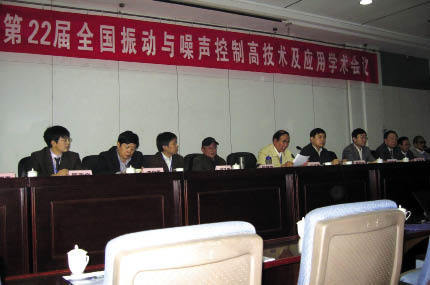Professor Ying’s Nobel Complex
“Virtual instruments are not the same as their traditional counterparts,” Ying said. “They refer to software-based tools which integrate data acquisition and signal conditioning, signal processing technology and PC technology.” Ying first came across the bold idea of making virtual instruments way back when he participated in the national defense nuclear project. In 1965, he researched the vibrations and noise of an explosion in an underground railway, and produced a dynamic analysis. But problems related to residual displacement in the underground railway couldn’t be solved with the available hardware. This inspired him to “use numerical algorithms and software to replace the hardware.”
In 1973, Ying attempted to solve these problems using a computer’s digital integral and digital fourier transformer instead of traditional methods employing analog integral and analog filtering. He finally succeeded in 1979 and produced the earliest example of a virtual instrument. That same year, at a meeting of the State Commission of Science and Technology for National Defense Industry, Ying introduced the core concepts of virtual instruments – the idea of making instruments using software. The concept was praised and supported by Zheng Zhemin, former director of the Institute of Mechanics, Chinese Academy of Sciences, Zhang Wei, late vice president of Tsinghua University and academician of the Chinese Academy of Sciences and Chinese Academy of Engineering, and Li Guohao, academician of the Chinese Academy of Sciences and Chinese Academy of Engineering and late president of Tongji University. Ying was ahead of his time, proposing the concept seven years earlier than the globally-recognized U.S.-based National Instruments, which first introduced the concept “software is an instrument” in the West.
In 1983, Ying Huaiqiao founded the China Orient Institute of Noise & Vibration with his life savings of RMB 300. Over the last three decades, the institute has been committed to sci & tech innovation. Every year, it holds an innovation festival on Jingzhe (Waking of Insects) day, the third seasonal division point, which heralds warmer days and spring rains. Ying hopes that every innovation will resemble spring thunder, injecting renewed vitality into society.
With the passion for rejuvenating the nation and benefiting all of humankind, the institute attaches great importance to talent cultivation, and cooperates with top universities such as Tsinghua and Peking University. It has nurtured a legion of scientific workers, who constitute the backbone of China’s virtual instrument research.
In 1988 Ying took his virtual instrument developed for modal analysis of Qiantang River Bridge and applied it to small rocket testing. The instrument was displayed at the Beijing New Technology Fair in March 1993, and later exhibited in Canada. It was implemented during rocket testing of the CZ-3 strap-on booster in 1995 and again in the modal testing of the mobile launch platform of the Shenzhou manned spaceship in 1996. In 2004 it was used in the modal analysis of the arm support system of exercises for overweight astronauts. At the Second National Virtual Instrument Seminar in 2007, the achievements of the Orient Institute were highly praised and Ying was dubbed “Father of China’s Virtual Instruments.”
 |
| Prof. Ying at the 22nd national conference on vibration and noise control technologies. |
Chasing Nobel
Scientists are like lighthouses for modern society. James Watt invented the steam engine, ushering in the industrial revolution. Albert Einstein changed human perceptions of space, and Alexander Graham Bell draw people nearer by inventing modern communication.
However, every scientist experienced extraordinary difficulties and setbacks on their way to success. A paragraph from ancient philosopher Mencius aptly describes scientific research: When Heaven invests great responsibility in a person, it first tests his resolve – exhausts his muscles and bones, starves his body, leaves him destitute, and confounds his every endeavor. In this way his patience and endurance are developed, and his weaknesses are overcome. Ying has survived strokes three times and suffered myocardial infarction four times. His fragile health however has never stopped him from working on the frontlines of scientific research.
Ying has invented 121 technologies, most notably the one for transfer function testing, real-time control and inversion. It was regarded as a new method to improve precision and range of virtual measurement instruments – a key technology on par with fiber optic communications invented by Charles Kuen Kao, who won the Nobel Prize in physics in 2009. The technology places China abreast of the U.S. as a leader in the most advanced technology in virtual instruments.

